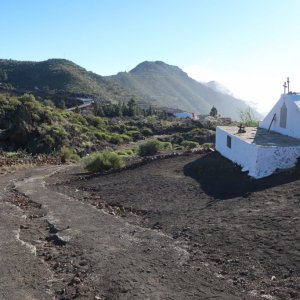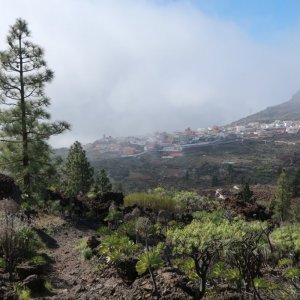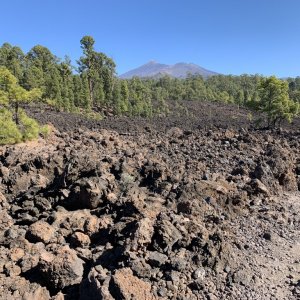Pauline
Forums Admin
Trip Report 2020-02 Spain, Tenerife
This was our first trip to the Canary Islands. We spent two weeks there at the end of January, into February 2020. We liked Tenerife and will return for another winter holiday. I am not writing a day by day trip report as I usually do, but instead an overview of the whole trip.
For those who don't know me, I have traveled a lot in Europe but always in Italy, France and Switzerland, not in Spain. My husband Steve and I are American but we moved to England 10 years ago.
GEOGRAPHY
The Canary Islands, part of Spain, are off the western coast of Africa less than 200 miles from southern Morocco. Tenerife is the largest and most populated island (population of 933,000). It is the most touristed island with large resorts on the south west coast. A large volcano, Mount Teide (summit at 12,000ft), is in the center of the island. Mount Teide is considered active and last erupted in 1909.
The island feels like one big mountain with flatter coastal areas on the edges where the resort towns and some of the older towns are located, steeper slopes rising up with agriculture and towns until the pine forest starts at about 1000m. There are many deep canyons (barrancos). Above the pine forest the volcanic area is covered in rubble and lava from the Mount Teide eruptions. You can drive from the south side to the north side over the volcanic area. The Anaga Peninsula in the north above Santa Cruz, the main city on Tenerife, is mountainous and has rainforest-like areas.
The island divides into two distinct geographical areas with Mount Teide on the dividing line. The southern part of the island is dry and barren, with the most sunshine and hottest temperatures. Instead of one long southern coast, the island comes to a point in the south with a south west and a south east coast. The main airport is at the southern tip. Most of the tourist development has been on the south west coast from Los Cristianos which runs into Playa de las Americas and on to Costa Adeje. Further along the coast are more resort areas ending at Los Gigantes with its steep cliffs. These areas are well developed with streets of hotels, condos and shops reaching well back from the coast and starting up the mountain.
The largest city, Santa Cruz de Tenerife, and nearby La Laguna are at the top of the south eastern coast. We only drove through this area and did not stop to visit. It is very built up.
View: https://www.google.com/maps/embed?pb=!1m18!1m12!1m3!1d449683.4808638654!2d-16.802852933033225!3d28.293713461525424!2m3!1f0!2f0!3f0!3m2!1i1024!2i768!4f13.1!3m3!1m2!1s0xc4029effe8682ed%3A0xb01a4bf1c84baf3c!2sTenerife!5e0!3m2!1sen!2suk!4v1581864415684!5m2!1sen!2suk
MY IMPRESSION
The Canaries is a sunny winter destination for Brits and Northern Europeans. It is perfect Brits because it is close (4.5hr flight) and in the same time zone. They mostly go to the resort towns on the south west coast. The northern Europeans seem to go more for the sunny weather and hiking. We came across many Germans on the hiking trails.
The only tropical places that we’ve gone to for winter breaks previously are Hawaii, where we vacationed many times, and Tahiti, where we went once. We visited these places from the US or Canada. We currently live in the UK. If I still lived in the US and was looking for a sunny winter break, I would not consider the Canaries because there are many similar or better destinations close by. I loved Hawaii but it is too long of a flight from the UK. I’ve never been to the Caribbean but have heard how much people love it. Those destinations would be better than the Canaries I think.
I loved the north west part of Tenerife where we stayed. I disliked the south west coast with the resorts. The beaches are beautiful but the resorts were too built up and busy. They are not like the resort areas on the Hawaiian Islands where you get a few big hotels and a small neighbourhood. There were not many high rises, which was nice, but many low rise apartment buildings. I imagine that if you found the right place in one of these resorts it could be nice, but it isn’t the place for me.
GENERAL
The time zone is GMT, the same as the UK but the Canaries are west of the UK and it feels like you are an hour or two off the time zone. In the UK the sun sets at 4:30pm in the winter but in Tenerife it set at 6:30pm. I know Tenerife is much further south, but I was surprised how late the sun set and how late it rose in the morning.
Many people speak English, but not all. We did fine with the language because there really are a lot of similarities with Italian.
There are no bugs! We did not come across mosquitoes or flies or any other annoying bugs in towns or out on the hiking trails.
The roads are not as steep as I thought they would be from what I read and the mountain roads were easy to drive.
There is a lack of public toilets in the towns and at the beaches but you can easily go into a restaurant or café to use the facilities.
WEATHER
We were looking for a place to get sunshine and warmth during the winter months and we found it. The weather was very good. We had sun most days, only one day with rain, and the temperatures were usually in the low to mid 70sF. One day was quite hot – over 80F.
Continued in the next post.
This was our first trip to the Canary Islands. We spent two weeks there at the end of January, into February 2020. We liked Tenerife and will return for another winter holiday. I am not writing a day by day trip report as I usually do, but instead an overview of the whole trip.
For those who don't know me, I have traveled a lot in Europe but always in Italy, France and Switzerland, not in Spain. My husband Steve and I are American but we moved to England 10 years ago.
GEOGRAPHY
The Canary Islands, part of Spain, are off the western coast of Africa less than 200 miles from southern Morocco. Tenerife is the largest and most populated island (population of 933,000). It is the most touristed island with large resorts on the south west coast. A large volcano, Mount Teide (summit at 12,000ft), is in the center of the island. Mount Teide is considered active and last erupted in 1909.
The island feels like one big mountain with flatter coastal areas on the edges where the resort towns and some of the older towns are located, steeper slopes rising up with agriculture and towns until the pine forest starts at about 1000m. There are many deep canyons (barrancos). Above the pine forest the volcanic area is covered in rubble and lava from the Mount Teide eruptions. You can drive from the south side to the north side over the volcanic area. The Anaga Peninsula in the north above Santa Cruz, the main city on Tenerife, is mountainous and has rainforest-like areas.
The island divides into two distinct geographical areas with Mount Teide on the dividing line. The southern part of the island is dry and barren, with the most sunshine and hottest temperatures. Instead of one long southern coast, the island comes to a point in the south with a south west and a south east coast. The main airport is at the southern tip. Most of the tourist development has been on the south west coast from Los Cristianos which runs into Playa de las Americas and on to Costa Adeje. Further along the coast are more resort areas ending at Los Gigantes with its steep cliffs. These areas are well developed with streets of hotels, condos and shops reaching well back from the coast and starting up the mountain.
The largest city, Santa Cruz de Tenerife, and nearby La Laguna are at the top of the south eastern coast. We only drove through this area and did not stop to visit. It is very built up.
View: https://www.google.com/maps/embed?pb=!1m18!1m12!1m3!1d449683.4808638654!2d-16.802852933033225!3d28.293713461525424!2m3!1f0!2f0!3f0!3m2!1i1024!2i768!4f13.1!3m3!1m2!1s0xc4029effe8682ed%3A0xb01a4bf1c84baf3c!2sTenerife!5e0!3m2!1sen!2suk!4v1581864415684!5m2!1sen!2suk
MY IMPRESSION
The Canaries is a sunny winter destination for Brits and Northern Europeans. It is perfect Brits because it is close (4.5hr flight) and in the same time zone. They mostly go to the resort towns on the south west coast. The northern Europeans seem to go more for the sunny weather and hiking. We came across many Germans on the hiking trails.
The only tropical places that we’ve gone to for winter breaks previously are Hawaii, where we vacationed many times, and Tahiti, where we went once. We visited these places from the US or Canada. We currently live in the UK. If I still lived in the US and was looking for a sunny winter break, I would not consider the Canaries because there are many similar or better destinations close by. I loved Hawaii but it is too long of a flight from the UK. I’ve never been to the Caribbean but have heard how much people love it. Those destinations would be better than the Canaries I think.
I loved the north west part of Tenerife where we stayed. I disliked the south west coast with the resorts. The beaches are beautiful but the resorts were too built up and busy. They are not like the resort areas on the Hawaiian Islands where you get a few big hotels and a small neighbourhood. There were not many high rises, which was nice, but many low rise apartment buildings. I imagine that if you found the right place in one of these resorts it could be nice, but it isn’t the place for me.
Los Cristianos
Looking towards Playa de las Americas, the largest resort on the southern beach.
GENERAL
The time zone is GMT, the same as the UK but the Canaries are west of the UK and it feels like you are an hour or two off the time zone. In the UK the sun sets at 4:30pm in the winter but in Tenerife it set at 6:30pm. I know Tenerife is much further south, but I was surprised how late the sun set and how late it rose in the morning.
Many people speak English, but not all. We did fine with the language because there really are a lot of similarities with Italian.
There are no bugs! We did not come across mosquitoes or flies or any other annoying bugs in towns or out on the hiking trails.
The roads are not as steep as I thought they would be from what I read and the mountain roads were easy to drive.
There is a lack of public toilets in the towns and at the beaches but you can easily go into a restaurant or café to use the facilities.
WEATHER
We were looking for a place to get sunshine and warmth during the winter months and we found it. The weather was very good. We had sun most days, only one day with rain, and the temperatures were usually in the low to mid 70sF. One day was quite hot – over 80F.
Continued in the next post.



















































